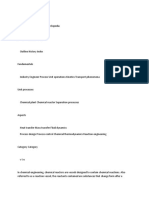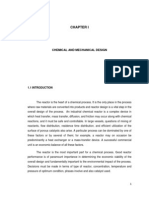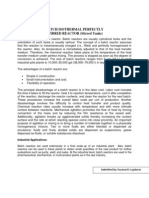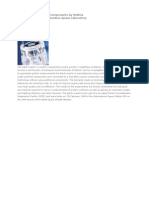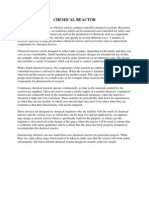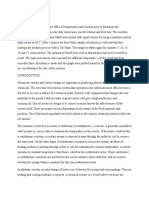0 ratings0% found this document useful (0 votes)
7 viewsChapter One: 1.1 Background
Chapter One: 1.1 Background
Uploaded by
teweleTubular reactors resemble batch reactors in that they contain flowing reactants, but in tubular reactors the flow is continuous and steady. In an ideal tubular reactor, reactants flow uniformly like solid plugs through the tube, with reaction time being constant across any tube cross-section. Initially high reaction rates diminish as the reactions progress through the tube. Turbulent flow is generally preferred over laminar flow as it improves mixing and heat transfer, but may require long reactors or high feed rates for slow reactions. Tubular reactors are commonly used industrially as they have no moving parts and high conversion per volume, and can be used for both homogeneous and heterogeneous reactions.
Copyright:
© All Rights Reserved
Available Formats
Download as DOCX, PDF, TXT or read online from Scribd
Chapter One: 1.1 Background
Chapter One: 1.1 Background
Uploaded by
tewele0 ratings0% found this document useful (0 votes)
7 views2 pagesTubular reactors resemble batch reactors in that they contain flowing reactants, but in tubular reactors the flow is continuous and steady. In an ideal tubular reactor, reactants flow uniformly like solid plugs through the tube, with reaction time being constant across any tube cross-section. Initially high reaction rates diminish as the reactions progress through the tube. Turbulent flow is generally preferred over laminar flow as it improves mixing and heat transfer, but may require long reactors or high feed rates for slow reactions. Tubular reactors are commonly used industrially as they have no moving parts and high conversion per volume, and can be used for both homogeneous and heterogeneous reactions.
Original Description:
lab
Original Title
Chapter One
Copyright
© © All Rights Reserved
Available Formats
DOCX, PDF, TXT or read online from Scribd
Share this document
Did you find this document useful?
Is this content inappropriate?
Tubular reactors resemble batch reactors in that they contain flowing reactants, but in tubular reactors the flow is continuous and steady. In an ideal tubular reactor, reactants flow uniformly like solid plugs through the tube, with reaction time being constant across any tube cross-section. Initially high reaction rates diminish as the reactions progress through the tube. Turbulent flow is generally preferred over laminar flow as it improves mixing and heat transfer, but may require long reactors or high feed rates for slow reactions. Tubular reactors are commonly used industrially as they have no moving parts and high conversion per volume, and can be used for both homogeneous and heterogeneous reactions.
Copyright:
© All Rights Reserved
Available Formats
Download as DOCX, PDF, TXT or read online from Scribd
Download as docx, pdf, or txt
0 ratings0% found this document useful (0 votes)
7 views2 pagesChapter One: 1.1 Background
Chapter One: 1.1 Background
Uploaded by
teweleTubular reactors resemble batch reactors in that they contain flowing reactants, but in tubular reactors the flow is continuous and steady. In an ideal tubular reactor, reactants flow uniformly like solid plugs through the tube, with reaction time being constant across any tube cross-section. Initially high reaction rates diminish as the reactions progress through the tube. Turbulent flow is generally preferred over laminar flow as it improves mixing and heat transfer, but may require long reactors or high feed rates for slow reactions. Tubular reactors are commonly used industrially as they have no moving parts and high conversion per volume, and can be used for both homogeneous and heterogeneous reactions.
Copyright:
© All Rights Reserved
Available Formats
Download as DOCX, PDF, TXT or read online from Scribd
Download as docx, pdf, or txt
You are on page 1of 2
CHAPTER ONE
INTRODUCTION
1.1 Background
Tubular reactors resemble batch reactors in provision, a tubular reactor is a vessel
through which flow is continuous, usually at steady state, and configured so that
conversion of the chemicals and other dependent variables are functions of position
within the reactor rather than of time. In the ideal tubular reactor, the fluids flow as if
they were solid plugs or pistons, and reaction time is the same for all flowing material at
any given tube cross section. Initially high driving forces, which diminish as the reactions
progress down the tubes. Flow in tubular reactors can be laminar, as with viscous fluids
in small-diameter tubes, and greatly deviate from ideal plug-flow behavior, or turbulent,
as with gases. Turbulent flow generally is preferred to laminar flow, because mixing and
heat transfer are improved. For slow reactions and especially in small laboratory and
pilot-plant reactors, establishing turbulent flow can result in inconveniently long reactors
or may require unacceptably high feed rates. . The majority of the selected chemicals are
exothermic but other endothermic reactions in tubular reactors are present in the
chemical industry, e.g. cracking in fired tubular reactors to produce ethylene and
propylene. Tubular reactors are used in the industry since they are relatively easy to
maintain due to no moving parts and usually have the highest conversion per reactor
volume of other types of reactor. Tubular reactors can be used either for homogenous
or heterogeneous reaction chemistry. Homogenous reactors have only one phase in the
reaction environment and heterogeneous have more than one. The temperature
changes quickly in the beginning of the reactor due to high reaction rate. The reaction
rate is generally affected by concentration of reactants and temperature which means
that the reaction rate is high in the beginning and then lowers trough the reactor and
the change in temperature follows accordingly. To keep the reaction rate high and
therefore increase the reaction conversion of with a given reactor cooling of exothermic
reactors and heating of endothermic reactors is employed.
As a consequence the heat transfer between the reactive stream and utility is strictly
connected with the reaction kinetics which therefore cannot be ignored when designing
the utility system.
You might also like
- Types of ReactorsDocument8 pagesTypes of ReactorsAli Ahmad94% (17)
- Stirred Tank Reactors in SeriesDocument25 pagesStirred Tank Reactors in SeriesChristopher Emeka Ominyi67% (3)
- Tubular Reactor Equipment 1.1.2 Background Study: Chapter 1Document3 pagesTubular Reactor Equipment 1.1.2 Background Study: Chapter 1teweleNo ratings yet
- Exp 6Document22 pagesExp 6Dhiyyah MardhiyyahNo ratings yet
- ReactorsDocument7 pagesReactorsLyka Balmes100% (1)
- Laboratorium Teknik II: Preliminary Study Plug Flow ReactorDocument4 pagesLaboratorium Teknik II: Preliminary Study Plug Flow ReactorAnonymous vjTWskvNo ratings yet
- Cinética Química UDocument16 pagesCinética Química UJesus Manuel Yallerco VenegasNo ratings yet
- L9-Tubular Flow ReactorDocument20 pagesL9-Tubular Flow ReactorCik Tiem Ngagiman82% (11)
- Design For A High Temperature Shift ConverterDocument43 pagesDesign For A High Temperature Shift ConverterAaron GyamfiNo ratings yet
- Types of Reactor2Document4 pagesTypes of Reactor2Aleem AhmedNo ratings yet
- Plug Flow ReactorDocument16 pagesPlug Flow Reactormirdza94No ratings yet
- Chemical ReactorDocument5 pagesChemical Reactornevelle4667No ratings yet
- Chapter One: 1.1 BackgroundDocument22 pagesChapter One: 1.1 BackgroundteweleNo ratings yet
- Hysys Project of Chemical Reaction Engineering: Prepared By: Mahmoud Mohamed ID: 141761Document9 pagesHysys Project of Chemical Reaction Engineering: Prepared By: Mahmoud Mohamed ID: 141761Mahmoud HendawyNo ratings yet
- Chapter One: 1.1 BackgroundDocument19 pagesChapter One: 1.1 BackgroundteweleNo ratings yet
- Tubular Flow Reactor ReportDocument19 pagesTubular Flow Reactor ReportN Afiqah Razak100% (1)
- Chemical Reactors: Batch Reactors Are Used For Most of The Reactions Carried Out in A Laboratory. The Reactants AreDocument4 pagesChemical Reactors: Batch Reactors Are Used For Most of The Reactions Carried Out in A Laboratory. The Reactants AreBranco RojasNo ratings yet
- Chemical ReactorDocument8 pagesChemical ReactorMahfuzur Rahman SiddikyNo ratings yet
- Chemical and Mechanical DesignDocument460 pagesChemical and Mechanical DesignNuriman K-monNo ratings yet
- Lab ReportDocument25 pagesLab ReportafiqahanuwarNo ratings yet
- Types of ReactorsDocument16 pagesTypes of Reactorsmunding21No ratings yet
- Comparison and Selection of ReactorsDocument7 pagesComparison and Selection of Reactorslivinusezeah54No ratings yet
- Reactor DesignDocument10 pagesReactor DesignKrystel Monica ManaloNo ratings yet
- 4.0 & 5.0 & ReferenceDocument12 pages4.0 & 5.0 & ReferenceAYALEYDENNo ratings yet
- Types of Continues ReactorDocument1 pageTypes of Continues Reactorriyad abdulqaderNo ratings yet
- Types of Continues ReactorDocument1 pageTypes of Continues Reactorriyad abdulqaderNo ratings yet
- Reactors1 9Document4 pagesReactors1 9Mourad kharbachNo ratings yet
- Lab 3 Plug FlowDocument29 pagesLab 3 Plug FlowHikaru MokaNo ratings yet
- Soran University Faculty of Engineering Department of Chemical EngineeringDocument11 pagesSoran University Faculty of Engineering Department of Chemical EngineeringAram Nasih MuhammadNo ratings yet
- P F RDocument4 pagesP F RMohamed Ragab MohamedNo ratings yet
- Report On Reactor Isomerization of Light Naphtha: Prepared byDocument8 pagesReport On Reactor Isomerization of Light Naphtha: Prepared byاحمد حمید کارسول عزیزNo ratings yet
- Plug FlowDocument17 pagesPlug FlowNurshahirahSapianNo ratings yet
- Plug Flow Reactor (PFR)Document5 pagesPlug Flow Reactor (PFR)Luis Alberto Domínguez MendozaNo ratings yet
- Student 4 Mini Project (Reaction Engineering)Document7 pagesStudent 4 Mini Project (Reaction Engineering)Muhammad KasyfiNo ratings yet
- Attachment - 1428685327598 - BP 101 BDocument24 pagesAttachment - 1428685327598 - BP 101 BOh DausNo ratings yet
- Assignment Reactor 1Document14 pagesAssignment Reactor 1DilaFirizqinaNo ratings yet
- Chemical Reactor2Document5 pagesChemical Reactor2Sohail AsgharNo ratings yet
- Choice of Reactors For Chemical ReactionsDocument4 pagesChoice of Reactors For Chemical ReactionsMegh JoshiNo ratings yet
- Plug Flow Reactor NotesDocument4 pagesPlug Flow Reactor Notesahmad pidotNo ratings yet
- Batch Reactor: Optical High Precision Components by Hellma in The European Columbus Space LaboratoryDocument16 pagesBatch Reactor: Optical High Precision Components by Hellma in The European Columbus Space Laboratoryangelie_gubatanNo ratings yet
- 2 Chemical Reactor To Reactor Safety PDFDocument41 pages2 Chemical Reactor To Reactor Safety PDFV DhinakaranNo ratings yet
- 1.1 AbstractDocument25 pages1.1 AbstractZati TarhiziNo ratings yet
- Reactor Design LessonDocument10 pagesReactor Design LessonKrystel Monica ManaloNo ratings yet
- CHPR5501 Adv. Reaction Eng. Part 1Document40 pagesCHPR5501 Adv. Reaction Eng. Part 1Elena TodorovskaNo ratings yet
- Aso Sardar - ReactorDocument17 pagesAso Sardar - Reactorاحمد حمید کارسول عزیزNo ratings yet
- PFR Lab ReportDocument21 pagesPFR Lab ReportValentinoDullSatin100% (1)
- Chemical ReactorDocument15 pagesChemical ReactorMithelesh KoulNo ratings yet
- Project Report NewDocument41 pagesProject Report Newrohith reddyNo ratings yet
- Reactors1 2Document4 pagesReactors1 2Mourad kharbachNo ratings yet
- Mole Balances: Industrial ReactorsDocument3 pagesMole Balances: Industrial Reactorsdina rodianaNo ratings yet
- TFRDocument19 pagesTFRsueeumuraNo ratings yet
- Abstract For CSTR Lab ReportDocument4 pagesAbstract For CSTR Lab ReportNabilah SyaheeraNo ratings yet
- Plug Flow Reactor (PFR)Document11 pagesPlug Flow Reactor (PFR)Wan AfiffNo ratings yet
- Selection of Reaction Vessel Simple/Ideal LifeDocument27 pagesSelection of Reaction Vessel Simple/Ideal LifeIdk 1No ratings yet
- Theory Thesis PFR ReationDocument18 pagesTheory Thesis PFR ReationAmit RewatkarNo ratings yet
- R SDocument6 pagesR S0a1l2i3.h4a5s6s7a8n9No ratings yet
- PFR ReactorDocument19 pagesPFR Reactorkhairi100% (2)
- Reactors1 35Document2 pagesReactors1 35Mourad kharbachNo ratings yet
- Unit 2Document56 pagesUnit 2Hariharan MothilalNo ratings yet
- Thermal Modelling of Power Transformers Using Computational Fluid DynamicsFrom EverandThermal Modelling of Power Transformers Using Computational Fluid DynamicsNo ratings yet
- Project For InternshipDocument63 pagesProject For Internshiptewele100% (1)
- Demineralized Process Water..Document52 pagesDemineralized Process Water..teweleNo ratings yet
- ADIGRAT UNIVERSITY - Fikadu.finsh - by NegasiDocument18 pagesADIGRAT UNIVERSITY - Fikadu.finsh - by NegasiteweleNo ratings yet
- Constructional Futures of BoilersDocument2 pagesConstructional Futures of BoilersteweleNo ratings yet
- Twe (1) ReportasDocument69 pagesTwe (1) ReportasteweleNo ratings yet
- Lecture - 1 For Process Industries OneDocument37 pagesLecture - 1 For Process Industries OneteweleNo ratings yet
- Penicillin L-5Document17 pagesPenicillin L-5teweleNo ratings yet
- Cement (Chapter 3)Document13 pagesCement (Chapter 3)teweleNo ratings yet
- Wine Production L 4Document16 pagesWine Production L 4teweleNo ratings yet
- Evaluation Questions For Chemical Engineering Internship: Water TreatmentDocument2 pagesEvaluation Questions For Chemical Engineering Internship: Water TreatmentteweleNo ratings yet
- Evaluation Questions For Chemical Engineering Internship: Water TreatmentDocument2 pagesEvaluation Questions For Chemical Engineering Internship: Water TreatmentteweleNo ratings yet
- Tagb PDFDocument2 pagesTagb PDFteweleNo ratings yet
- Beer Production L-3Document16 pagesBeer Production L-3teweleNo ratings yet
- Mebrhit GebremariamDocument80 pagesMebrhit GebremariamteweleNo ratings yet
- Corrosion: 1, Breakdown Maintenance and Unscheduled BreakdownsDocument4 pagesCorrosion: 1, Breakdown Maintenance and Unscheduled BreakdownsteweleNo ratings yet
- Chapter 23 Three-Phase Induction MotorsDocument9 pagesChapter 23 Three-Phase Induction MotorsteweleNo ratings yet
- Plug Flow Reactor DesignDocument3 pagesPlug Flow Reactor DesignteweleNo ratings yet
- Evaluation Questions For Chemical Engineering Internship: Water TreatmentDocument2 pagesEvaluation Questions For Chemical Engineering Internship: Water TreatmentteweleNo ratings yet
- Chapter One: 1.1 BackgroundDocument22 pagesChapter One: 1.1 BackgroundteweleNo ratings yet
- Chapter One: 1.1 BackgroundDocument19 pagesChapter One: 1.1 BackgroundteweleNo ratings yet

















